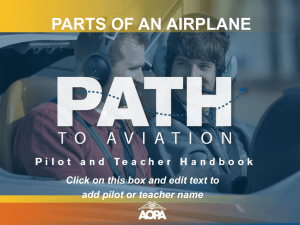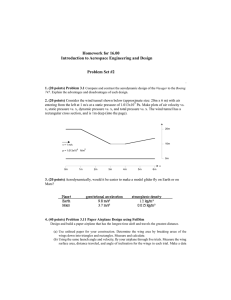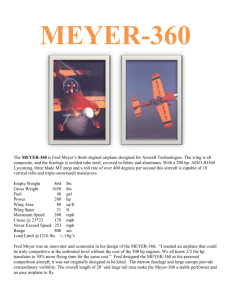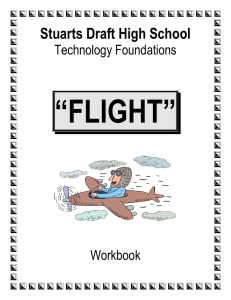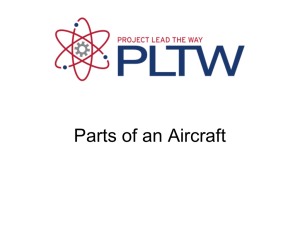Lesson 1: The Airplane
advertisement
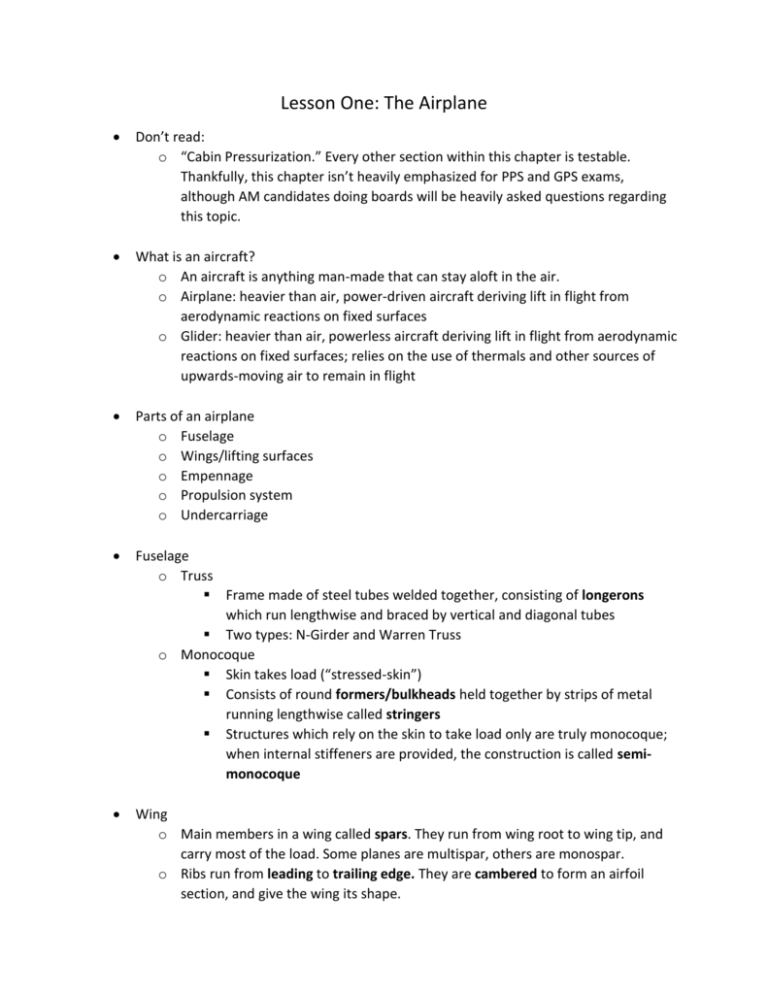
Lesson One: The Airplane Don’t read: o “Cabin Pressurization.” Every other section within this chapter is testable. Thankfully, this chapter isn’t heavily emphasized for PPS and GPS exams, although AM candidates doing boards will be heavily asked questions regarding this topic. What is an aircraft? o An aircraft is anything man-made that can stay aloft in the air. o Airplane: heavier than air, power-driven aircraft deriving lift in flight from aerodynamic reactions on fixed surfaces o Glider: heavier than air, powerless aircraft deriving lift in flight from aerodynamic reactions on fixed surfaces; relies on the use of thermals and other sources of upwards-moving air to remain in flight Parts of an airplane o Fuselage o Wings/lifting surfaces o Empennage o Propulsion system o Undercarriage Fuselage o Truss Frame made of steel tubes welded together, consisting of longerons which run lengthwise and braced by vertical and diagonal tubes Two types: N-Girder and Warren Truss o Monocoque Skin takes load (“stressed-skin”) Consists of round formers/bulkheads held together by strips of metal running lengthwise called stringers Structures which rely on the skin to take load only are truly monocoque; when internal stiffeners are provided, the construction is called semimonocoque Wing o Main members in a wing called spars. They run from wing root to wing tip, and carry most of the load. Some planes are multispar, others are monospar. o Ribs run from leading to trailing edge. They are cambered to form an airfoil section, and give the wing its shape. o Compression struts, drag and anti-drag wires all designed to take load. o Struts are placed externally to support the wings. Wings without struts are called cantilever. o Ailerons, placed on the trailing edge near the wing tip, are control surfaces which facilitate roll (lateral control). o Flaps, placed on the trailing edge near the wing root, help facilitate landing/taking-off. o Winglet, small, nearly-vertical surface which impedes the formation of wingtipvortices -> decreases induced drag. o Chord, imaginary line from leading to trailing edge. Mean aerodynamic chord (MAC) is the average length of the chord across an entire wing. o Span, length from wingtip to wingtip. Empennage o Horizontal stabilizer, provides longitudinal stability. o Elevator, hinged surface attached to horizontal stabilizer, provides pitch (longitudinal control). o Fin/Vertical stabilizer, provides directional stability. o Rudder, hinged surface attached to fin, provides yaw (directional control). o Trim tab, Adjustable tab fixed or hinged to a control surface, which helps relieve some of the load from the pilot. o Stabilator, combined hor. Stabilizer and elevator. Canard o Tail-section placed in front of the airplane. (Like the Mirage). Propulsion o Cowling, encloses engine and streamlines airplane to reduce drag. Provides cooling of the engine by ducting cool air in. Cowl flaps on high-performance engines incorporated into cowling to control the amount of cool air coming in. o Engine mount, supports the engine. Absorbs vibrations from engine, prevents shaking of fuselage. o Firewall, divides engine from firewall. Protects cockpit. Undercarriage o Either fixed gear or retractable. o Read on types of wheels: split axle, tripod, single spring leaf cantilever, single strut o Single leaf cantilever found on Cessna planes. o Retractable gear allows for the removal of parasite drag on wheels in flight. Because of small size of tail wheels, the tail wheel of tail-wheel aircraft is generally fixed. o Tricycle Steerable third wheel forward of main gears. Nose-over tendencies reduced. Ground looping tendencies reduced. Visibility greater when taxiing/taking-off/landing Greater maneuverability on ground under high-wind conditions due to negative angle of attack on wings (less prone to get “lifted off” on ground) Greater controllability on ground in X-wind conditions Easy to learn o Tail-dragger Third wheel is rearward of main gears; nose generally pointed up. Tail wheel has less parasite drag than nose wheels (smaller) Tail wheel is cheaper and easier to maintain. Broken tail wheel = no big deal Easier to man-handle on the ground Less prop damage on rough/sandy/loose terrain (less likely for stuff to come up and impact props) Constant use in rough fields -> less likely to sustain airframe damage Easier for changeover ops in winter o Shock absorbers – four methods Low pressure tires (issue with bounce) Oleo Forcing oil through one side of a piston to the other through a small orifice. Displacement of oil delayed, and hence absorbs shock of landing. Only used to absorb shock of landing (simple oleo systems). Shock from taxiing can be handled by devices like Oleo-Aerol (spring) or Oleo-Pneumatic (compressed air) Rubber, usually used in conjunction with oleo. Take the form of rubber discs or doughnuts. Spring steel o Brakes Provide quick deceleration after landing. Differential brakes ensure better control after landing, prevents ground loops, better maneuverability on ground. Control systems o Ailerons Wheel (control column) control (turning wheel left/right) typically cables and pulleys, although push and pull rods may be used too. Wheel left -> left aileron up, right aileron down. Lift decreased on left aileron, forcing left wing down. Lift increased on right wing due to increased camber, right wing up. o Elevators Wheel control (pushing forward/pulling back) cables/pulleys, rocking beam and cradle, or push/pull rod systems Wheel back, elevator up Decreases lift on tail, forces nose up. o Rudder Rudder pedal control. Left pedal -> rudder hinges left. Deflects tail right, so nose yaws left. o Read up on trim Read up on “Construction Materials” and “Corrosion” Stresses o A force or combination of forces exerting a strain, which is a distortion to a body. 1. Compression 2. Tension 3. Torsion 4. Shearing 5. Bending o Flutter, rolling or weaving motion caused by vibrations to a structure. Occurs in wings and control surfaces and may lead to structural failure structures must be made stiff against bending and twisting. Loads o How much wing can lift. o Wing loading of an airplane is the gross weight of the airplane divided by the area of the lifting surfaces. o Span loading is gross weight divided by span. o Power loading is gross weight divided by horsepower of engine. o **Load factor, ratio of live load (loading on wings in flight) to dead load (loading on wings on the ground, due to gravity alone). AKA g-forces. 60o banked turn = 2g o Maneuvering speed (VA): maximum speed for an aircraft at which full deflection of the controls can be made without exceeding the design limit load factor. Log books o Used for recording timings, incidents, locations, and anything else of interest. o Air time = when the plane leaves the supporting surface and terminates when it touches the ground o Flight time = total time from the moment an airplane first moves under its own power FOR THE PURPOSE OF TAKING OFF until the moment it comes to rest at the end of the flight o Recorded to nearest five minutes o More about this in Air Law Aircraft Classes and Categories o Normal category Max gross weight operations are permitted, but spins, steep turns, etc. are not permitted. Some planes cross over into utility category as well (C-152 and C-172). o Utility category Can withstand stronger loads than normal category Certain maneuvers can be carried out, albeit at reduced weight. o Aerobatic category (can do crazy stuff) o Commuter category (carry passengers, smaller than transport) o Transport category (airliners, other large planes) o Additional category Fire-fighting, photography, amateur-built
